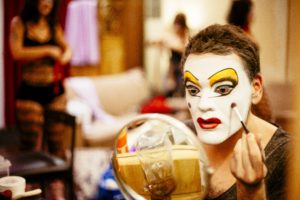Anthony Hudson / Carla Rossi (Portland, OR): Looking for Tiger Lily
Theatre/Drag/Music/Multimedia
BIO
ANTHONY HUDSON is a multidisciplinary artist, performer, and filmmaker. He lives in Portland, OR among lush greenery, sprawling gentrification, and a not-mutually-exclusive fear of bridges and earthquakes. Anthony is perhaps best known as Portland’s premier drag clown CARLA ROSSI, an immortal trickster whose attempts at realness almost always result in fantastic failure. Career highlights include Pepper Pepper’s Critical Mascara for TBA (PICA), the Cascade AIDS Project Art Auction, Seattle PrideFest, and Conduit Dance’s DANCE+ Festival, and hosting alongside Coco Peru, Peaches Christ, Jinkx Monsoon, Bianca Del Rio, and more. Anthony & Carla host and program their LGBTQ film series QUEER HORROR bimonthly at the historic Hollywood Theatre, and they recently received their second RACC Artist Focus project grant for the full-length version of LOOKING FOR TIGER LILY, premiering in Fall 2016.
PERFORMANCE SYNOPSIS
Carla Rossi, Portland’s premier drag clown and (in her words) “ghost of white privilege,” confronts white supremacy and the confusion of “mixed” identities – of living in-between, particularly sexually and racially. LOOKING FOR TIGER LILY forces Carla (but also Anthony) to trace personal and ancestral lines to work through and recreate childhood memories, namely watching Tiger Lily’s “Ugg-A-Wugg” song from Mary Martin’s Peter Pan. While this is technically a “one-woman-ish” show, a large element of the show – the storytelling – comes through with the use of video and slides, inspired by the Power Points Anthony’s father used to give as a Grand Ronde Tribal social worker. His father’s workshops for State social workers taught the importance of the Indian Child Welfare Act and the lived realities of assimilation and intergenerational trauma, and included typical “dad jokes,” pictures of the Chemawa Indian School where he grew up, and his family history within the Tribe.
VIEW A VIDEO OF THE GENESIS FOR THIS PIECE

